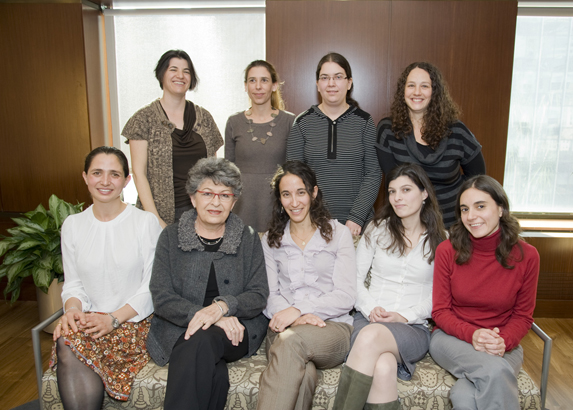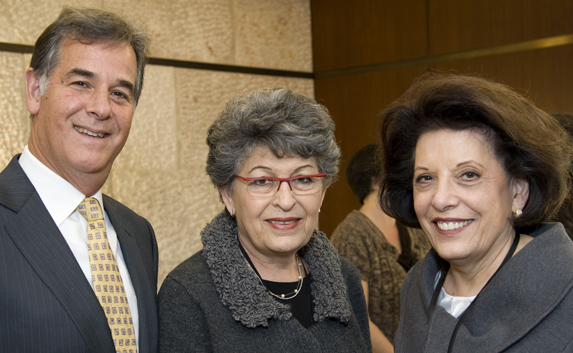
Standing, L-R: Dr. Noa Corem (Weinberg), Dr. Yael Artzy-Randrup, Dr. Maytal Toroker, Dr. Hilla Weidberg. Sitting, L-R: Dr. Naama Geva-Zatorsky, Prof. Varda Rotter, Dr. Ruth Scherz-Shouval, Dr. Rina Rosenzweig, Dr. Shlomit Greenberg.
People, as Weizmann Institute of Science President Prof. Daniel Zajfman often says, are our greatest natural resource. These are not just words; he is behind a push by the Institute to leverage the power of people—women as well as men.
The Institute has long recognized a major problem in science: women are dramatically underrepresented. And while this is true worldwide, change begins at home, and thus Weizmann has undertaken multiple initiatives to promote women in science. One such program, the National Postdoctoral Award Program for Advancing Women in Science, addresses the area in which there is the single greatest loss of female scientists, both globally and in Israel: the postdoctoral years.
The Award Program by the Numbers
- Established in 2007, the program funds around 10 candidates per year.
- As of the end of the 2009-10 academic year, a total of 44 women had received awards.
- There are approximately 60 applications each year for the 10 slots.
- Award amounts range from $15,000 to $25,000, per applicant per year.
- Postdoctoral research takes from two to four years and is key to establishing a scientific career.
- A shift can already be seen: in 2006, 26 percent of female graduates took a postdoctoral position abroad; in 2009, 42 percent.
For Israeli scientists, postdoctoral training abroad in the world’s leading universities, laboratories, and institutions is vital to the quality of the country’s science. It is also a critical phase in every scientist’s career. However, social, cultural, and financial pressures mean that investing time and other resources in postdoctoral training is particularly challenging for women.
In response, in 2007, the Weizmann Institute initiated a program to encourage gifted Israeli female scientists to enroll in ambitious postdoctoral programs. Now known as the National Postdoctoral Award Program for Advancing Women in Science, this competitive prize supports outstanding female PhD graduates from all Israeli academic institutions of higher learning, not just the Weizmann Institute. It provides an opportunity for talented female scientists to be trained at leading international laboratories, thereby leading to a career as a top scientist. The award, primarily based on academic excellence, is granted to women who have already been accepted for postdoctoral work in prominent laboratories abroad.
The considerable promise and high level of talent of the awardees is confirmed by external accolades; for example, Dr. Naama Geva-Zatorsky, now conducting postdoctoral work at Harvard Medical School, received a prestigious L’Oréal-UNESCO For Women in Science international fellowship for 2012, and Dr. Hagar Gelbard-Sagiv, currently a postdoc at the California Institute of Technology (Caltech), was a L’Oréal-UNESCO recipient in 2011. Both women are also graduates of the Weizmann Institute.
Weizmann’s Prof. Varda Rotter, the current President’s Advisor for Advancing Women in Science, is now leading the program. She and several award recipients recently came together with supporters of the program to discuss its real-world impact on the women’s lives. Gathering in the Midtown Manhattan offices of the American Committee for the Weizmann Institute of Science, the recipients came from as nearby as downtown and as far away as Toronto:
- Dr. Yael Artzy-Randrup, University of Michigan, investigates the interface of ecology and evolution, particularly as it relates to infectious diseases.
- Dr. Noa Corem (Weinberg), University of Pennsylvania School of Medicine, studies metabolism and how the whole metabolic system works together in disease and health, with a focus on diabetes.
- Dr. Naama Geva-Zatorsky, Harvard Medical School, examines the body’s microbiota—for example, how do humans, whose bodies host thousands of species, benefit from being part of such an ecosystem?
- Dr. Shlomit Greenberg, New York University, uses functional magnetic resonance imaging (fMRI) to study visual systems; e.g., very small eye movements as they relate to perception and awareness.
- Dr. Rina Rosenzweig, University of Toronto, uses nuclear magnetic resonance (NMR) to understand the molecular mechanism involved in protein aggregation. This is key to fighting a number of diseases, including Alzheimer’s.
- Dr. Ruth Scherz-Shouval, Massachusetts Institute of Technology (MIT) – Whitehead Institute for Biomedical Research, seeks to understand tumor microenvironments, which could lead to the ability to regulate such microenvironments via transcription factors and other means.
- Dr. Maytal Toroker, Princeton University, studies computational chemistry in the Department of Mechanical and Aerospace Engineering, including designing materials such as new solar cells.
- Dr. Hilla Weidberg, MIT’s Koch Institute for Integrative Cancer Research, investigates genetics, including cell cycles and protein quality-control systems.
Before meeting with Weizmann friends and supporters, the women and Prof. Rotter first discussed their research. Some of the scientists already knew each other; others were meeting for the first time; all found common connections. Prof. Rotter spoke passionately of the challenges unique to women scientists, sharing her own experiences of the difficulties inherent in postdoctoral work, being a top-notch researcher, and raising a family.
However, the women were there not only to share their research, but to speak to several supporters of the program about how the award has made a real difference in their lives. Attendees, including Arlyn Imberman, Meryl Jo Jaffe, Ellen Merlo, and the Revson Foundation, were interested in hearing the everyday details, such as the specific items the women needed funds for, as well as suggestions for improving the awards.
The award provides support for a handful of brilliant and brave young women, says Prof. Varda Rotter.
All the female postdocs present were married, and almost all had multiple children. This means that in order to work abroad, two career paths must be coordinated: the scientist and her spouse. The women spoke of how the award makes it possible for them to have balanced lives; virtually all referenced using the award for support services, such as childcare, thus enabling them to work the long hours necessary in their labs. Because most high-ranking institutions are in expensive areas such as Boston, New York, and other large cities, the cost of housing, school for the children, and even groceries and transportation are all prohibitive on a postdoc’s stipend, and the women said that the award helps defray such expenses.
The consensus among the scientists was that the award “makes all the difference” and enables them to have some semblance of normal life under challenging circumstances. For example, Dr. Toroker, who is at Princeton and has a five-year-old son in day care, pointed out that it can take quite some time for the accompanying spouse to receive a work visa, much less find a job, meaning that the woman researcher may be the sole earner for some time. As she put it, “I probably couldn’t do my postdoc without the award.”
In addition, the award is seen by the recipients as an affirmation, an acknowledgment of both their talent and of the complexities of their lives. Dr. Artzy-Randrup, who has a three-and-a-half-year-old child, is conducting her postdoctoral work at the University of Michigan, but her husband is working in Florida. She emphasizes that, as vital as the financial support is, the award is “also very important in terms of message: you’re not a bad mom because you’re a scientist. Women can take the lead.”
This sentiment was echoed by Dr. Geva-Zatorsky, the L’Oréal-UNESCO laureate who is at Harvard Medical School, as she said, “The award strengthens me.”

L-R: Marshall S. Levin, Executive Vice President and CEO; Prof. Varda Rotter; Ellen Merlo, Chair, New York Region and Vice Chair, Donor Relations and National Programs.
In fact, in response to requests from supporters to identify ways to make the award even more effective, the women indicated that it would be helpful if letters announcing the award were sent to the recipients’ department heads, principal investigators, and the like. Even—or perhaps particularly—in such prestigious labs, the women report that they are often the only female postdocs; thus, publicizing the fact that there is support out there for gifted women scientists provides an extra level of validation. For example, Dr. Greenberg of NYU has two children; her husband, also in academia, is seeking work, meaning she is currently the sole earner. She said, “It is still unusual to see other women postdocs, and certainly not other mothers.” Because the award is merit-based, it is yet another recognition of the scientist’s achievements and potential—important things for her employer to know.
“I probably couldn’t do my postdoc without the award,” says Dr. Maytal Toroker of Princeton
The need for the National Postdoctoral Award Program for Advancing Women in Science is evidenced by its popularity (there are currently six times more applicants than available awards) and its success in increasing both the numbers of women scientists and the numbers of scientists in Israel. While the recipients are not required to return to Israel (or the Weizmann Institute) after their postdoctoral training, it is hoped that they will choose to establish their careers in Israel. Many of the scientists at the meeting were emphatic about their desire to return to Israel—while they are grateful for this time abroad, they look forward to raising their families and having successful scientific careers in Israel, and contributing to the country’s economy, growth, and bright prospects.
The award means more than money to both the women and the philanthropists. Besides the economic support, the social, moral, and professional boost provided by the award, as well as its increasingly high profile, will help carry the women, and science, forward. Dr. Weidberg of MIT sums it up well: “The award makes it all happen.”
Support for the National Postdoctoral Award Program for Advancing Women in Science provided by Marilyn Barnett; the Clore Foundation; the Dym Family Foundation; Lillian Erdeljan; Andrea Klepetar Fallek; the Morris Feder Family Philanthropic Fund; Judy and Jerry Felsenthal; Sonya Friedman; Janine Gordon; Jerry and Anita Gutkin; Norman and Esther Harris; Linda and Stephen Hayman; Karen Jacobson; Stanley Alan Jacobson; the Kaplan Family Fund of RSF Social Finance; the Kittay Foundation, Inc.; Michael and Marcy Klein; Stuart and Francie Klein; Graham Landau; Dr. Bessie F. Lawrence; the Pearl Welinsky Merlo Foundation; the Estate of Esther Ragosin; the Charles H. Revson Foundation; the Mike Rosenbloom Foundation; the Rowland and Sylvia Schaefer Family Foundation; Axel and Sara Lee Schupf; Donald Schwarz; the Herbert J. Seligmann Charitable Trust; Marion Silberberg; Maxine F. Singer; Jeanette B. Smolarski; S. Donald Sussman; and Fredda Weiss.
